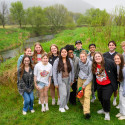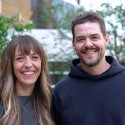Advances

(Advances gives a glimpse of the many significant research projects at the university. Tell us about your discoveries by e-mailing: wisweek@news.wisc.edu.)
150th child enrolled in UW asthma project
A baby born at the end of August has joined 149 other children in a university-community project to help determine the causes of childhood asthma.
Known as COAST (Childhood Origins of Asthma), the project seeks to explain why some young children develop full-blown asthma and others don’t. Robert Lemanske, a nationally recognized asthma expert and professor of pediatrics and medicine, oversees the federally funded COAST project, which is based on Lemanske’s theory that children develop asthma because of a combination of bad genetic luck and a common childhood virus.
At the center of Lemanske’s theory are immune system hormones called cytokines. Some children inherit a cytokine imbalance and, as a result, become allergic to environmental triggers like house dust or pet dander. Because not everyone who has allergies develops asthma, he believes that something has to direct the allergic response into the lower airway. If the COAST project shows Lemanske’s theory to be correct, it would help physicians identify children at risk of developing asthma and to intervene aggressively at the first signs of the disease to forestall lung damage. The COAST project is a joint effort of area hospitals and clinics. Information: 263-8539.
Dane County land-use project touts UW technology
The kickoff of an innovative local land-use project will feature a newly developed suite of tools developed by the university’s Land Information and Computer Graphics Facility.
“Planning Analyst” is a series of modules that help visualize alternative development patterns, evaluate impacts of proposed development and combine desired planning outcomes with relevant ordinances and standards. With the ability to better understand, forecast and visualize alternative land-use scenarios, communities will be able to make better informed land-use choices, says Ben Niemann, a professor in the College of Agricultural and Life Sciences.
Dane County Executive Kathleen Falk is scheduled to introduce the project, “Shaping Dane’s Future: Community-Based Land Use Planning Demonstration Project,” today, Sept. 8, in Verona, which has been selected as the pilot site for the project. The project will explore ways to engage Dane County citizens in the land use planning process.
Campus lab tests for soybean pests
For a second year, the university will help soybean growers monitor their fields for the soybean cyst nematode. Soybean growers can mail in a soil sample for analysis. The soybean cyst nematode attacks soybean roots. It has become one of the crop’s most serious pests, according to Ann MacGuidwin, a nematologist in the College of Agricultural and Life Sciences. The nematode can reduce soybean yields even when plants appear normal above the ground.
“The only way to know for sure if the nematode is limiting yields is to run a soil test,” MacGuidwin says. “A soil test also shows the pest’s population density in a field, which is important for deciding whether or not to plant a soybean variety with resistance to the nematode.”
Tags: research




